Introduction
As a disclaimer, it is important to note that a great number of books and reports have been written on the recent history of wind turbine manufacturing, each describing in great details the successes and failures of the different concepts. Therefore, there is no need to write what has already been written; instead this post focuses on the combined wind-resource and wtg testing efforts in the 1970s, which aimed at better understanding how feasible was the development of large scale wind energy, and what was needed to be known/coded in order to achieve this.
As explained earlier, much of the works on wind turbine design and siting were presented at a series of workshops, which took place from 1973 at the initiative of Joseph Savino and his colleagues of the Lewis Research Center. The global context was (and you all know it), the first oil crisis. A great overview of the beginning of the wind energy program in the USA can be found on the NASA website. Here is an excerpt of p. 200:
- “Die Geschichte der Windenergienutzung 1890-1990“, summarized here.
- “Signs of Hubris : The Shaping of Wind Technology Styles in Germany, Denmark, and the United States, 1940–1990”, see a summary here.
Drawing from past experiences, and aiming at producing MW-size turbines ready for industrial production, NASA went on taking further the downwind 2-bladed concept.
Workshop and conferences, 1973-1980
Let me start by providing a series of links (when available) to the various workshop proceedings. The symbol [*] means that I only have a hard copy, or at least one volume of the proceedings in my possession, while [x] means that I could not find neither a digital nor a hard copy (for now).
- 1973: Wind Energy Conversion Systems workshop (Washington DC, USA).
- 1974: Advanced Wind Energy Systems (Stockholm, 1974) [*]
- 1975: Second workshop on Wind Energy Conversion Systems (Washington DC, USA).
- 1976: International Symposium on Wind Energy System (Cambridge, UK). [*]
- 1977: Third Biennial Conference and Workshop on Wind Energy Conversion Systems. (Washington DC, USA)
- 1978: Second International Symposium on Wind Energy Systems (Amsterdam, NL). [*]
- 1979: Wind energy innovative systems conference proceedings (Colorado Springs, USA).
- 1979: Conference and Workshop on Wind Energy Characteristics and Wind Energy Siting (Portland, USA).
- 1979: Large Wind Turbine Design Characteristics and R&D Requirements (Cleveland, Ohio).
- 1980: Third International Symposium on Wind Energy Systems (Lyngby, DK) [x].
I have deliberately decided to limit the talk to the conferences only up to 1980, because by then the industry and the research institutes had reached a higher level of maturity. See for instance the amount of publications mentioning “wind energy” in the Google Scholar database, and in the Google Ngram dataset below. After 1980, the Danish wind energy research really took off, and most of the tools we use today (Flex, WaSP for instance), were developed back then.

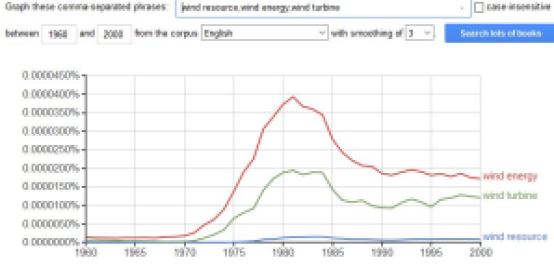
National programs
It is interesting to see, from the proceedings of those workshops and conferences, how the individual national programs supporting the development of wind energy have evolved. Each of those examples allow for much more refined analysis (in later posts…), but here is an overview:
1973 (Washington DC, USA): only is the USA program mentioned and advertised. The aim is to gather past experience and understand what it takes to take it to the next level. The presence of Hütter, who developed downwind 2-bladed turbines in Germany, and was a great scientist, was decisive for the design of the MOD turbines.
1974 (Stockholm, Sweden): Beside the American program, several others are presented: Canada, Netherlands, Sweden, UK. For the specific cases of France and Denmark:
- the French representative confirms that France has given up with wind energy.
- the Danish representatives look back at the Gedser turbine economics with fuel prices of 1974, and conclude that wind may be viable but are skeptical about the technology. Some of the discussions during the conference may have led to the decision of refurbishing the Gedser turbine (the measurement campaign was carried out in 1977-1979), partly financed by the ERDA (see here p52 of the pdf). As explained in great details here, a commission was set up in October 1974, and it made recommendations as to supporting the development of wind power in Denmark as early as 1975.
Together with the American program, both the Swedish and the Dutch plans are quite ambitious, with a great level of detail. In the US there are plans to produce large wind turbines (100kW with the first MOD in 1974), and quickly go up in scale (up to MW-size by the end of the decade). A WMO initiative aims at better characterizing the wind resource globally.
1975 (Washington DC, USA):
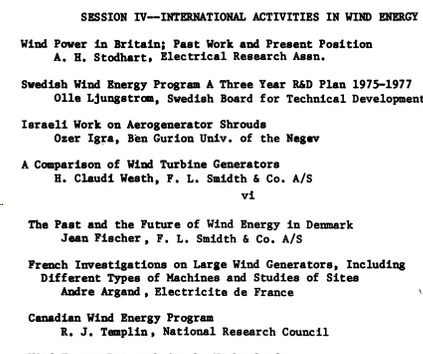
In this workshop, the Swedish representative presents results of the initial studies of the program presented the year before. As explained in 1974, there are no plans to directly build up machines, but instead the work focuses at a research level, on the feasibility of wind energy in Sweden.
As to the Danish delegates, they present the favorable findings of the DEFU 1974 report. Their main concern is esthetics of the turbine, and the presenter (from FLS Smidth), proposes rather exotic designs, that are very far from what Riisager was building at the time:
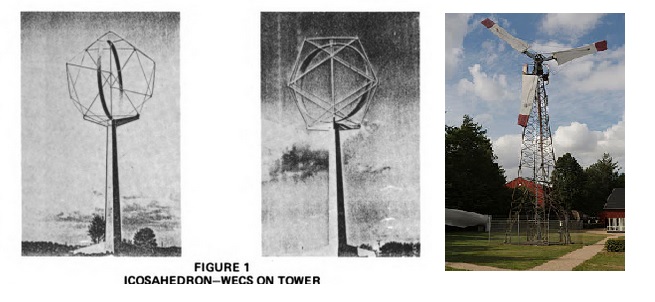
The British delegate explains as in 1974, that there are no plans yet by the government. The Israeli makes a presentation on shrouded rotors. The French delegate shows some nice plots from their defunct program, and as in the 1974 conference the Canadian representative displays their plans using vertical axis turbines. Somewhat also focused on vertical axis turbines, the Dutch delegation shows the first picture ever in a wind conference, of the Cabauw mast (widely used still today, it is 215m tall) !
1976 (Cambridge, UK): As you can see from the Table of Contents, there was no specific presentations about national programs, but instead many technical talks. One noticeable event is the presence of Helge Petersen who was one of Risø engineers who helped design the Tvind turbine in 1975. Later, in 1977, he took on the direction of the Risø wind turbine test center and worked on the Nibe turbines.
1977 (Washington DC, USA):
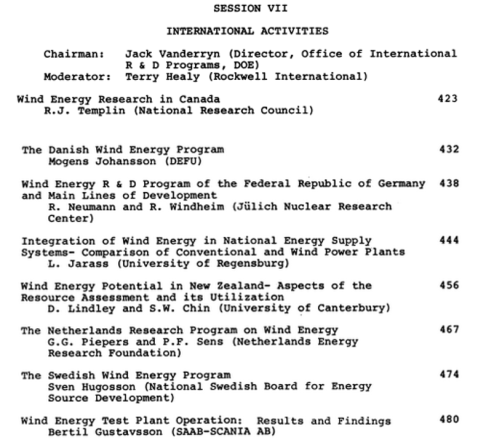
Mr. Templin from Canada, as the previous workshops, focuses on vertical axis turbines (Darrieus type), which makes his contributions, in the light of today’s experience, interesting in several aspects: why did so many people focus on VAWT in the 1970’s, and how is this experience feeding into the modern VAWT prototypes (most of them on floating structures), this is something I’d like to investigate further. It is the same for the Dutch program, which also focused on vertical axis turbines.
It was at this workshop, about 4 years after the renewed interest for wind energy science conferences, that the Danish representative made a very important contribution, by providing a detailed plan on their national program. There is a lot in this proposal:
- the testing of the refurbished Gedser turbine (1977-1979)
- the construction of the Nibe A and B turbines (1979 and 1980)
- the first Danish wind atlas (it came out in 1980)
What Mogens Johansson explains reflects the reality of the Danish wind turbines being installed in the late 1970’s:

As to the German representatives, they promote a national program similar to the Danish one, only with the use of two bladed turbines following the design principle of Hütter; the New-Zealanders on their side provide some interesting considerations on wind energy production in the energy mix of the island.
Lastly, the Swedes, who had finished their 3-years R&D program (they did start early, in 1974) provide some very interesting results: mainly that horizontal axis turbines are to be preferred, that they now have quantified the wind resource in different part of sweden, and have also investigated social and environmental aspects (safety, noise, bird, interference).
1978 (Amsterdam, Netherlands):
I only have a hard copy of the first volume of those proceedings (ToC is here), see what the national programs session look like:
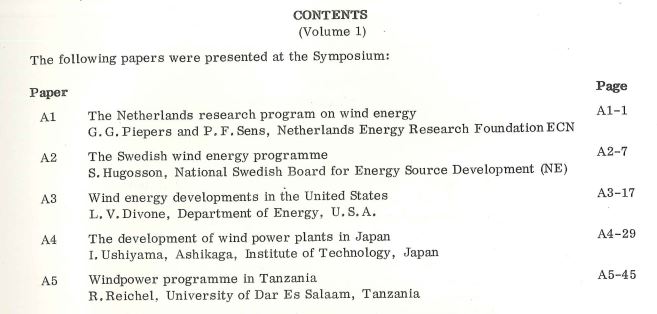
As in 1977, the Dutch delegate presents their experience with a Darrieus prototype. Some considerations about off-grid wind turbine solutions for both electricity supply and irrigation is provided by the Tanzanian delegate. The Japanese participant provides an exhaustive and very enlightening overview of the developments of wind power in Japan, as well as a plan similar to the Swedish initiative presented in 1974.
The main presentations are from the USA and Sweden. Building up on the success of phase I, which gave the scandinavian state great confidence in large scale wind energy, it is decided to fund two major projects in Sweden:
- a wind-resource mapping and forecasting project.
- the design and erection of many small (10kw) turbines, and a couple of large (1-2MW) prototypes (HAWT, 2-3 blades). The design, fabrication, and installation of the prototypes will be awarded via a nation-wide tender.
Louis Divone’s talk (DOE), is very detailed. It provides highlights of the findings in the various work packages that started off in the past years:
- the experience with the MOD0 turbine, and the continuation of the MOD program towards MW-size machines in the following years.
- the development of new materials and research on the most cost-effective structures.
- the creation of international R&D programs under the IEA umbrella.
- the ERDA funding to the Gedser campaign.
I would also like to highlight two articles from this conference:
- First of all the validation of the Lissaman wake model which I talk about in details in my first post: “wake interation in an array of windmills – theory and preliminary results”, by T. Faxén (Sweden).
- Secondly, the wonderful test setup and test results report about the Gedser turbine by Per Lundsager (Denmark). A copy of the Risø final report is available from the DTU website. I will make a series of specific posts on the Gedser turbine (first and second lives) at some stage.
1979 (Colorado Springs, Portland, and Cleveland, USA): I will only write briefly about those in this post, because they do not contain a lot of presentations on the national programs. There are, however, **extremely interesting** discussions about the MOD turbines in the Cleveland (at Lewis) meeting proceedings, give it a look. I recommend reading from page 425 of the pdf:
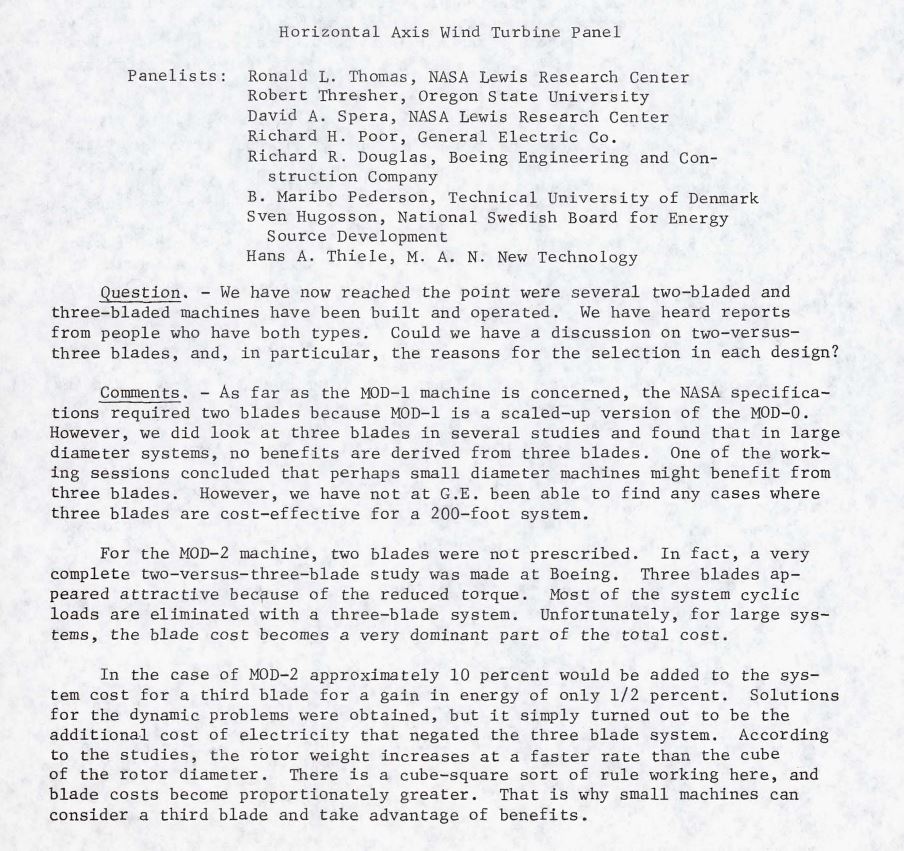
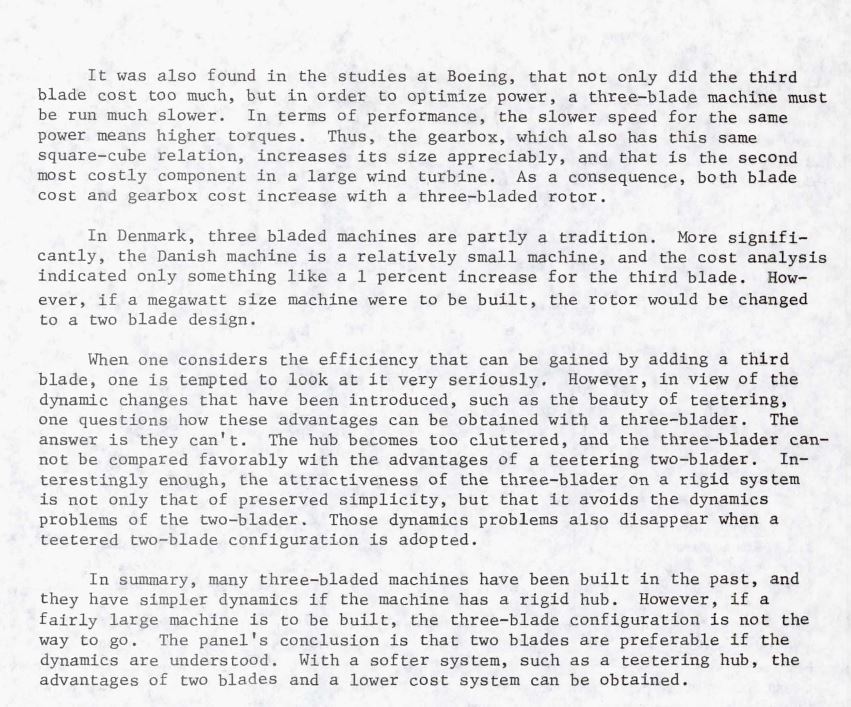
1980 (Lyngby, Denmark): As I write those words, I am awaiting for a copy of the proceedings, which I bought in AbeBooks. So the post might get updated by mid-January 2018.
Wrapping up
We have been through about 7 years of the early days of wind energy renewal, by focusing on presentations about national wind energy programs in a series of workshops and conferences led by the “MOD-turbines” initiative in the US. There is much to tell about each individual contributors, and about their findings. From my side I note that:
- Wind resource and site assessment have been going together with WTG design since the beginning of those workshops. It was not necessarily the case in the age of pionneers (Juul, Hütter, Golding) (*), where the focus was really on making the turbine work and operate long enough.
- The experience from the Gedser turbine, a long-lasting technology, was not passed on to the USA when started the ERDA program in 1973. Instead, 2-bladed downwind turbines (advocated by Hütter, as I understand) were preffered.
- A great amount of tools and methods (see the first post about Lissaman), especially design codes, as well as micro- and meso scale flow models, were produced thanks to generous funding from the US, but also notably from Sweden which started very early a very extensive program.
Comments/questions welcome,
Rémi
(*) at the same, when living in Denmark, one experiences almost every day that there is enough energy in the wind to power us all …
